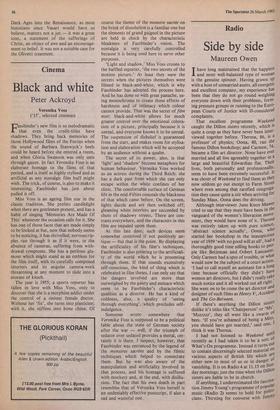Cinema
Black and white
Peter Ackroyd
Veronika Voss ('15', selected cinemas)
Fasbinder's new film is so melodramatic that even the credit-titles have shadows. They bring back memories of those Hollywood films of the Forties when the sound of Barbara Stanwyck's heels could be heard before she entered a room, and when Gloria Swanson was only seen through gauze. In fact Veronika Voss is an elaborate homage to the films of that period, and is itself as highly stylised and as artificial as any nostalgic film buff might wish. The trick, of course, is also to make it interesting; Fassbinder has just about pulled it off.
Miss Voss is an ageing film star in the classic tradition. She prefers candlelight when there are gentlemen present, and has a habit of singing 'Memories Are Made Of This' whenever the occasion calls for it. She has one of those faces that are made simply to be looked at but, now that nobody seems to be noticing, it has shrivelled; nervous rip- ples run through it as if it were, in the absence of cameras, suffering from with- drawal symptoms. She has a perilous gla- mour which might stand as an emblem for the film itself, with its carefully composed interiors and its angular camera-work threatening at any moment to slide into a morass of kitsch.
The year is 1955; a sports reporter has fallen in love with Miss Voss, only to discover that she is a morphine addict under the control of a sinister female doctor. Without her 'fix', she turns into plasticine; with it, she stiffens into bone china. Of
course the theme of the monstre sacree on the brink of dissolution is a familiar one but the elements of grand guignol in the picture are held in check by the characteristic bleakness of Fassbinder's vision. The nostalgia is very carefully controlled because it is being used here to serve other purposes.
'Light and shadow,' Miss Voss croons to the baffled reporter, 'the two secrets of the motion picture.' At least they were the secrets when the pictures themselves were filmed in black-and-white, which is why Fassbinder has adopted the process here. And he has done so with great panache, us- ing monochrome to create those effects of harshness and of intimacy which colour cannot provide. That was the secret of film noir; black-and-white allows for much greater control over the emotional colora- tion of a picture, principally because it is unreal, and everyone knows it to be unreal. The suspension of disbelief is guaranteed from the start, and makes room for stylisa- tion and elaboration which will be accepted by an audience without a qualm.
The secret of its power, also, is that 'light' and 'shadow' become metaphors for human behaviour. Veronika Voss worked as an actress during the Third Reich: she has a dark past from which she can only escape within the white confines of her clinic. The comfortable surface of German life in the mid-Fifties conceals the blackness of that which came before. On the screen, lights dazzle and are then switched off; gleaming white interiors are succeeded by shots of shadowy streets. There are con- trasts everywhere, and the characters in this film are impaled upon them.
At this late date, such devices seem somewhat contrived if not positively an- tique — but that is the point. By displaying the artificiality of his film's techniques, Fassbinder is also pointing to the artificiali- ty of the world which he is presenting through them. If that sounds excessively self-conscious, the kind of thing which is celebrated in film theses, I can only say that the dangers involved are more than outweighed by the gaiety and menace which seem to be Fassbinder's characteristic qualities as a director. He has a kind of coldness, also, a quality of 'seeing through everything', which precludes self- indulgence.
Someone wrote somewhere that Veronika Voss is supposed to be a political fable about the state of German society after the war — well, if the triumph of sedator over sedated provides a moral, cer- tainly it is there. I suspect, however, that Fassbinder was entranced by the legend of the monstres sacrees and by the filmic techniques which helped to consecrate them. But he was also aware of the manipulation and artificiality involved in that process, and his homage is suffused with mockery and, at the end, with disillu- sion. The fact that his own death in part resembles that of Veronika Voss herself is an undeniably effective postscript, if also a sad and wasteful one.














































 Previous page
Previous page